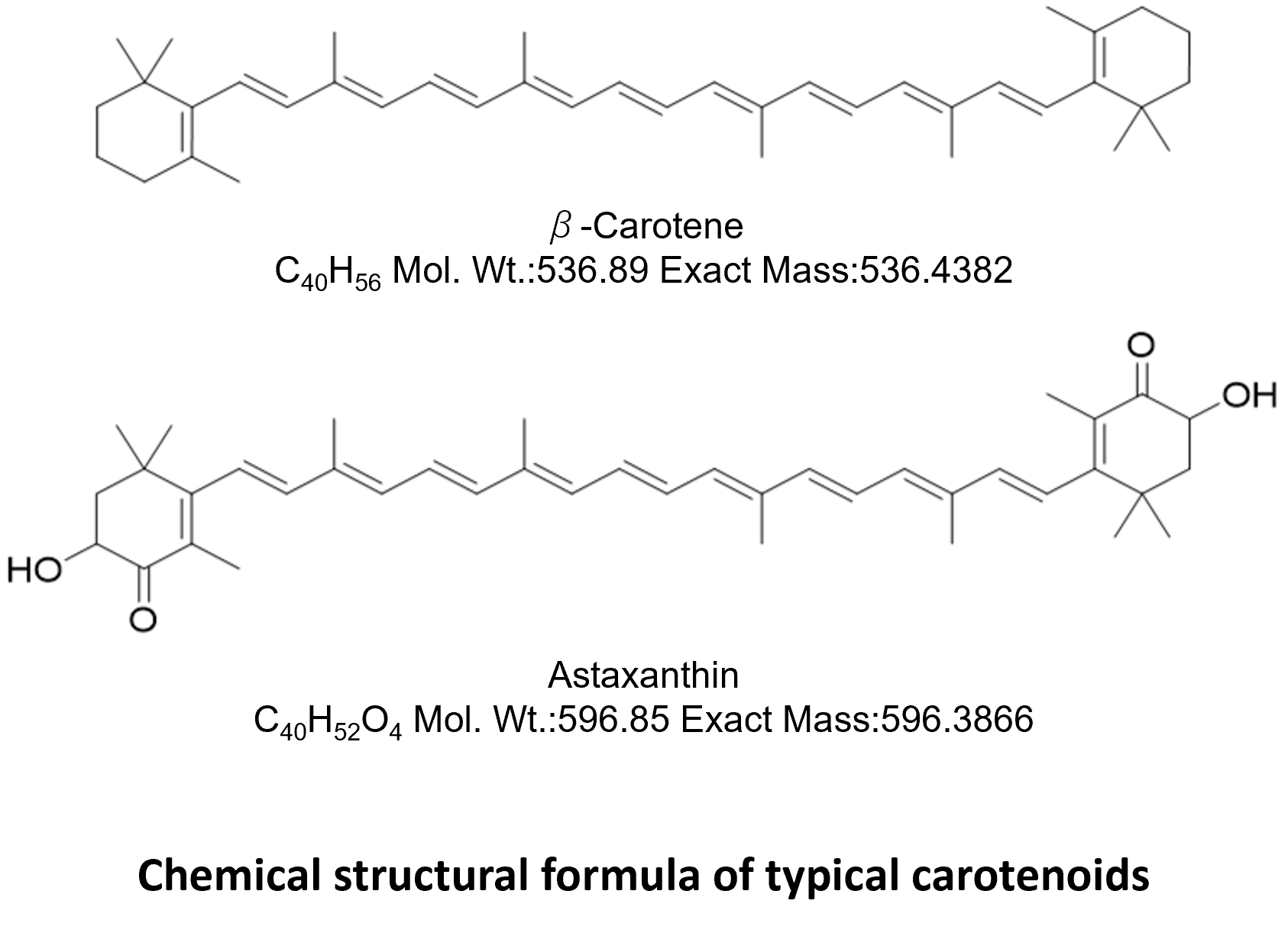Microbial Carotenoids
Introduction
Since living organisms can produce many chemical substances in their metabolic systems, their functions can be maximally utilized to produce highly functional substances at high efficiency without the chemical synthesis process.
Carotenoids are typical pigments produced by living organisms in their metabolic systems. They are well known as red or yellow pigments in tomatoes and carrots and as nutrients. Typical carotenoids include beta-carotene and astaxanthin. Some microorganisms also produce carotenoids.
To enable the use of carotenoid-producing microorganisms, NITE has conducted advanced carotenoid measurements and analysis of carotenoid production and metabolism in microorganisms.

Analyzed Microorganisms
NITE selected 43 microorganisms such as yeasts and actinomycetes and analyzed the extracts by liquid chromatograph - mass spectrometry (LC/MS) to confirm whether they produced carotenoids and to identify the carotenoids they produced.
The detailed analysis results are available to be downloaded from the DBRP (Data and Biological Resource Platform). (DBRP is only available in Japanese.)
In the analysis result column of the table below, you can download photographs of the colony shapes from "Colony", images of the cell shapes from "Cell", nucleotide sequences from "Genome", predicted carotenoid-related gene sequences from "Gene Prediction", and LC/MS measurement results from "LC/MS", respectively.
| No. | Phylum | Strain | Analysis result |
|---|---|---|---|
| 01 | Actinobacteria | Micrococcus luteus NBRC 3333 | Colony LC/MS |
| 02 | Actinobacteria | Kocuria rosea NBRC 15588 | LC/MS |
| 03 | Actinobacteria | Kocuria flava NBRC 107626 | Genome LC/MS |
| 04 | Actinobacteria | Streptomyces mirabilis NBRC 13450 | LC/MS |
| 05 | Actinobacteria | Streptomyces olivochromogenes NBRC 13067 | Colony LC/MS |
| 06 | Actinobacteria | Actinophytocola gilvus NBRC 109453 | Colony Genome Gene Prediction LC/MS |
| 07 | Actinobacteria | Actinoplanes teichomyceticus NBRC 13999 | Colony Genome Gene Prediction LC/MS |
| 08 | Actinobacteria | Angustibacter luteus NBRC 105387 | Colony LC/MS |
| 09 | Actinobacteria | Asanoa ishikariensis NBRC 14551 | Colony Genome Gene Prediction LC/MS |
| 10 | Actinobacteria | Asanoa ferruginea NBRC 14496 | Colony Genome Gene Prediction LC/MS |
| 11 | Actinobacteria | Cellulomonas aerilata NBRC 106308 | Genome Gene Prediction LC/MS |
| 12 | Actinobacteria | Nocardia seriolae NBRC 15557 | Colony Genome LC/MS |
| 13 | Actinobacteria | Streptoalloteichus hindustanus NBRC 15115 | Colony LC/MS |
| 14 | Actinobacteria | Streptomyces cellostaticus NBRC 12849 | LC/MS |
| 15 | Bacteroidetes | Flavobacterium glycines NBRC 105008 | Genome Gene Prediction LC/MS |
| 16 | Bacteroidetes | Marinilabilia salmonicolor NBRC 15948 | LC/MS |
| 17 | Firmicutes | Bacillus vietnamensis NBRC 101237 | Genome Gene Prediction LC/MS |
| 18 | Proteobacteria | Corallococcus coralloides NBRC 100076 | LC/MS |
| 19 | Proteobacteria | Pseudomonas alcaligenes NBRC 14159 | Genome Gene Prediction LC/MS |
| 20 | Proteobacteria | Pseudomonas parafulva NBRC 16636 | Genome Gene Prediction LC/MS |
| 21 | Proteobacteria | Sphingomonas astaxanthinifaciens NBRC 102146 | Genome Gene Prediction LC/MS |
| 22 | Proteobacteria | Sphingomonas jaspsi NBRC 102120 | Genome Gene Prediction LC/MS |
| 23 | Proteobacteria | Sphingomonas pruni NBRC 15498 | Genome Gene Prediction LC/MS |
| 24 | Proteobacteria | Sphingomonas trueperi NBRC 100456 | Genome Gene Prediction LC/MS |
| 25 | Proteobacteria | Altererythrobacter ishigakiensis NBRC 107699 | Genome LC/MS |
| 26 | Proteobacteria | Paracoccus marinus NBRC 100637 | LC/MS |
| 27 | Rhodothermaeota | Rubricoccus marinus NBRC 107124 | Genome LC/MS |
| 28 | (Bigyra) | Aurantiochytrium sp. NBRC 102614 | LC/MS |
| 29 | (Bigyra) | Botryochytrium radiatum NBRC 104107 | LC/MS |
| 30 | (Bigyra) | Oblongichytrium sp. NBRC 102618 | LC/MS |
| 31 | (Bigyra) | Ulkenia amoeboidea NBRC 104106 | LC/MS |
| 32 | (Bigyra) | Aurantiochytrium sp. NBRC 111922 | LC/MS |
| 33 | (Bigyra) | Thraustochytriaceae sp. NBRC 111921 | LC/MS |
| 34 | (Bigyra) | Thraustochytrium sp. NBRC 111915 | LC/MS |
| 35 | (Bigyra) | Schizochytrium sp. NBRC 102617 | LC/MS |
| 36 | Ascomycota | Neonectria coccinea NBRC 104641 | LC/MS |
| 37 | Mucoromycota | Phycomyces blakesleeanus NBRC 33097 | LC/MS |
| 38 | Mucoromycota | Blakeslea trispora NBRC 32295 | LC/MS |
| 39 | Mucoromycota | Mucor circinelloides f. circinelloides NBRC 4554 | LC/MS |
| 40 | Basidiomycota | Rhodotorula toruloides NBRC 0559 | Cell LC/MS |
| 41 | Basidiomycota | Rhodotorula aurantiaca NBRC 0754 | Cell Genome Gene Prediction LC/MS |
| 42 | Basidiomycota | Rhodotorula mucilaginosa NBRC 0909 | Genome Gene Prediction LC/MS |
| 43 | Basidiomycota | Rhodotorula toruloides NBRC 10032 | Genome Gene Prediction LC/MS |
This study was sponsored by New Energy and Industrial Technology Development Organization (NEDO).
Analytical Instruments
The mass spectrometer used for the analysis is introduced below.
Contact us
- Biotechnology Evaluation and Development Division, Biological Resource Center, National Institute of Technology and Evaluation
-
Address:2-49-10 Nishihara, Shibuya-ku, Tokyo 1510066, Japan MAP
Contact Form


